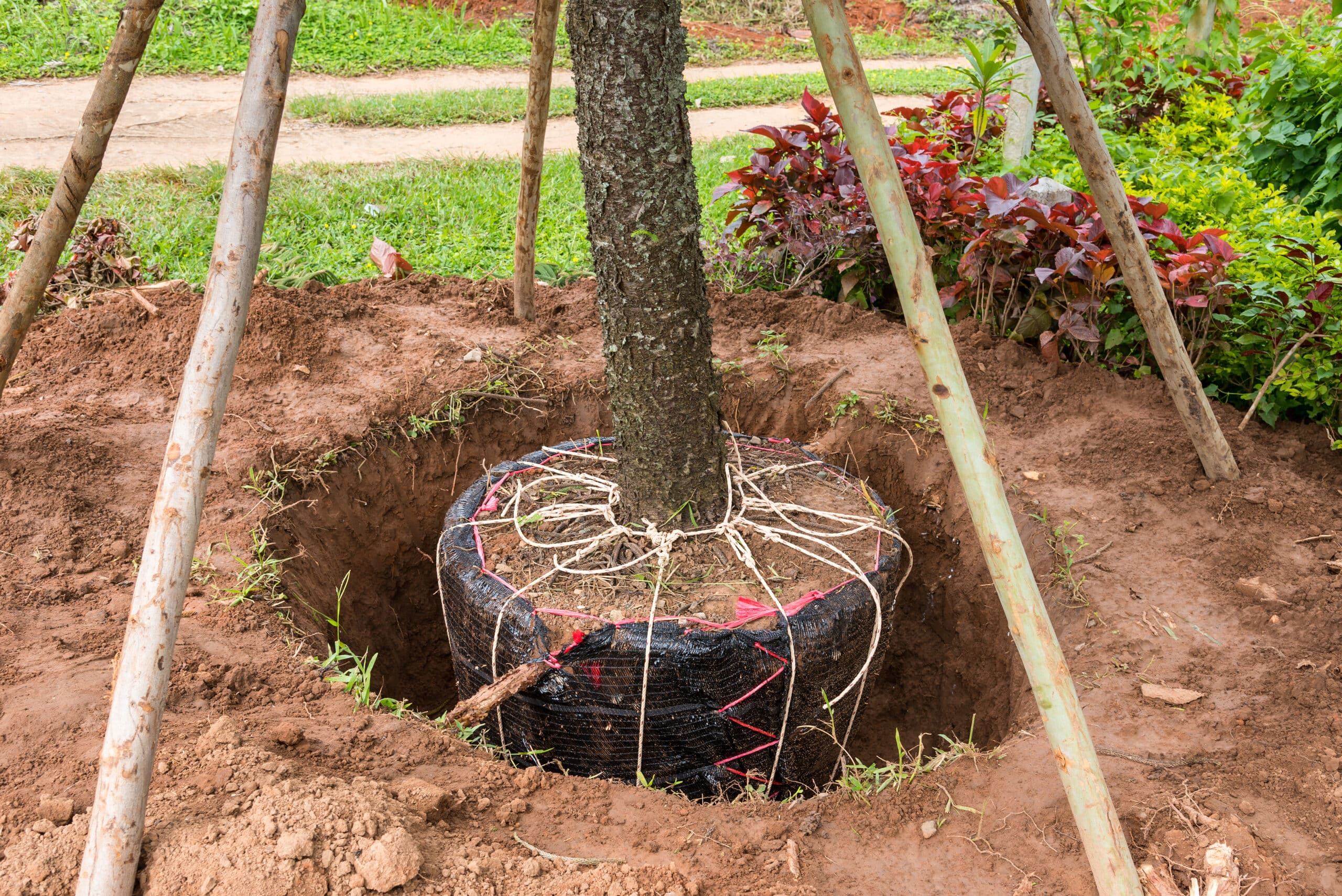Not all trees are rooted for life.
You planted it with care. Watched it grow. Over the years, it’s become part of your property’s character — a piece of living architecture. But sometimes, even the most beloved trees outgrow their welcome. They crowd walkways. Threaten foundations. Or suddenly stand in the way of a renovation you didn’t foresee years ago.
The good news? Moving a mature tree isn’t just possible — it’s often the best choice for both the tree and your property. And when it’s done with expert care, relocation can give that tree a second life in a spot where it can continue to thrive for decades to come.
How to know when a tree needs to move
1. It’s outgrowing its space
Mature trees often come with powerful, wide-spanning roots that extend far beyond the canopy. While this might be great for stability in the wild, on private property it can create havoc—rupturing water lines, displacing walkways, and undermining home foundations. If you’re starting to see physical signs like cracked driveways or uneven patios, or if you’re worried about what lies underground, it’s a strong signal that relocation is the responsible next step.
2. It’s blocking vital sunlight
When your tree casts a beautiful dappled shade over your yard, it may be doing more than keeping you cool. It might also be starving your lawn, garden beds, or solar panels of much-needed sunlight. That once-perfect placement can become problematic as trees mature. Relocating the tree helps ensure your entire ecosystem thrives—not just the tree itself.
3. New construction is on the horizon
Adding an outdoor kitchen, home addition, or pool is exciting—but not if it comes at the expense of a prized tree. You don’t have to choose between growth and preservation. Tree relocation allows you to break ground on your next chapter while still honoring and saving what matters.
4. It’s competing with other trees
Crowded canopies and tangled roots are signs of botanical competition. Left unchecked, both trees suffer. Early relocation of one tree gives both species a shot at thriving without constantly competing for the essentials: water, light, nutrients, and space.
5. Its value is better appreciated elsewhere
Whether it’s a rare cultivar or a tree planted by a family member decades ago, some trees deserve a more prominent stage. Strategic relocation can reposition these natural assets to a place where their aesthetic and emotional impact is amplified—for you, your guests, or the generations after you.
6. You’re preserving a legacy
Some trees carry history — the oak your grandfather planted, the cedar that marked the boundary of an old homestead, the elm under which generations played. These trees become part of a family’s identity, and the thought of losing them can feel like erasing a chapter. Fortunately, relocation allows legacy trees to move with you, or at least stay safely rooted as property needs evolve.
7. Drainage or soil issues are affecting health
Too much water. Not enough. Clay-heavy soil. Sandy runoff. Trees are sensitive to their environment, especially as urban landscapes shift around them. If your tree’s leaves are yellowing, branches are dying back, or fungus keeps creeping in, it may be reacting to the soil — not sickness. A site assessment can determine whether relocation to a better-draining or more nutrient-rich area could restore your tree’s health.
8. Pests or diseases are site-specific
While some pest infestations spread easily, others are more localized and worsened by specific conditions such as dense shade or poor airflow. If you’ve treated the problem repeatedly with little success, relocation to a sunnier, breezier spot may break the cycle and give it a fresh start.
9. You’re rethinking your landscape design
Landscape aesthetics evolve. What once served as a focal point may no longer align with your goals for biodiversity, sustainability, or even water conservation. Tree relocation gives you the freedom to reshape your space without sacrificing the time and growth invested in a mature tree.
10. You want to increase property value
Mature trees can increase a home’s value by up to 15% — but only when they’re placed correctly. A poorly located tree can make future buyers nervous about root damage or maintenance costs. By relocating trees to enhance visual flow and reduce risk, you can improve both aesthetics and long-term return.
11. You’re planning to xeriscape
As water restrictions increase and sustainability becomes a priority, many homeowners are swapping thirsty lawns for native grasses and rock features. But what about that water-loving magnolia in the middle of it all? Strategic relocation allows you to shift the tree to an irrigated zone or transition zone, letting you achieve both sustainability and aesthetic goals.
12. Wind or storm exposure is increasing
Stronger storms. Bigger gusts. If your tree used to be shielded by neighboring buildings or structures that no longer exist, it may now be vulnerable. Some species are particularly prone to windthrow, and a sudden storm can uproot a century-old tree in minutes. Rather than wait for a disaster, relocate it to a protected site where it can root deeper and grow safer.
13. Neighborhood changes impact your lot
From new development next door to grading changes that alter water runoff, a tree that was once perfectly positioned might now be in harm’s way. Instead of watching it decline in an incompatible setting, relocation gives it a second chance in an area that aligns with new conditions — protecting your landscape investment and ecological balance.
14. You’re investing in long-term sustainability
Sustainability isn’t just about reducing waste or conserving water. It’s about creating a living, evolving landscape that continues to benefit future generations. A well-placed tree can reduce cooling costs, clean the air, support wildlife, and increase soil stability. Relocating trees to maximize these benefits — especially in underutilized or eroding parts of your property — is a powerful, future-focused decision.
15. The tree has outlived its original context
Not all tree placements are permanent. A tree that made sense in a former garden design may now be overshadowing your view, obstructing entryways, or growing uncomfortably close to updated structures. If its presence feels more frustrating than functional, relocation allows the tree to contribute in a different way — without resorting to removal.
16. You want to showcase a unique species
Some trees are treasures — rare cultivars, architectural specimens, or slow-growing heritage species that deserve to be admired. But if they’re stuck behind sheds, hidden in corners, or overshadowed by larger neighbors, they may go unnoticed. Tree relocation can bring these botanical gems front and center — adding not just beauty, but distinction to your property.
17. Safety is becoming a concern
Visible lean, exposed roots, hollow trunks, or proximity to play areas and structures can all raise red flags. While some trees can be pruned or braced, others may require relocation to reduce risk. Our relocation process includes a full safety assessment to ensure the move extends the life of the tree while protecting everything — and everyone — around it.
18. You’re stewarding a conservation easement or legacy property
Caring for a legacy property or conservation site means balancing heritage with ecological integrity. Sometimes, this includes moving trees that were planted before long-term land planning was prioritized. We help landowners restore natural ecosystems, preserve view corridors, and protect native species through strategic, sensitive tree relocation services that honor both history and habitat.
Relocation isn’t a setback — it’s a strategy
There’s a common myth that moving a tree means something went wrong. In reality, relocation is often a proactive, strategic decision that reflects care, stewardship, and long-term thinking. Whether your tree is a landmark or simply in the wrong place at the wrong time, moving it allows it to continue growing without compromise. It’s a solution that respects both the tree’s past and your property’s future.
Why clients choose Environmental Design, Inc.
We don’t just move trees — we move legacies. With over four decades of experience and a team of highly skilled technicians, Environmental Design, Inc. has handled some of the most challenging, iconic tree relocations in the country. Our clients include architects, developers, city planners, cultural institutions, and homeowners who understand that a well-preserved tree is worth the investment. From our patented ArborLift® system to expert soil preparation and post-move care, we treat each tree like the living legacy it is.
Let’s talk trees.
You don’t have to say goodbye to the tree you love — and you don’t have to live with the problems it’s creating. With the right timing and the right team, tree relocation can be a transformational decision for your landscape.
Visit www.treemover.com to start the conversation with Environmental Design, Inc. Our team is ready to assess, plan, and move your tree with the care it deserves.






Join the discussion 2 Comments